Centauri Dreams
Imagining and Planning Interstellar Exploration
Light, Dry Atmosphere of a ‘Super-Earth’
We’re probing the atmospheres of exoplanets both from the Earth and from space. Transmission spectroscopy allows us to look at the spectra of starlight at various wavelengths as a transiting planet passes first in front of its host star, and then moves behind it. Now we have news of a successful detection of gases in the atmosphere of a super-Earth, using data from the Hubble Space Telescope. The team, made up of researchers at University College London and Catholic University of Leuven (Belgium) calls this a significant first.
“This is a very exciting result because it’s the first time that we have been able to find the spectral fingerprints that show the gases present in the atmosphere of a super-Earth,” said Angelos Tsiaras, a PhD student at UCL, who developed the analysis technique along with colleagues Dr. Ingo Waldmann and Marco Rocchetto in UCL Physics & Astronomy. “Our analysis of 55 Cancri e’s atmosphere suggests that the planet has managed to cling on to a significant amount of hydrogen and helium from the nebula from which it formed.”
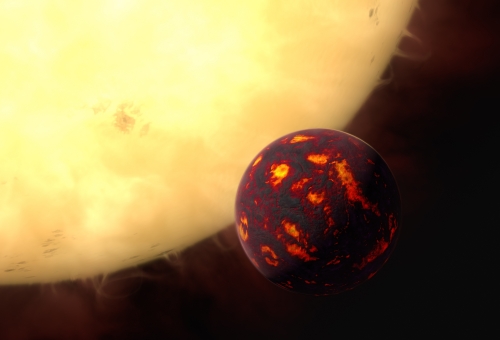
Image: This artist’s impression shows the super-Earth 55 Cancri e in front of its parent star. Using observations made with the NASA/ESA Hubble Space Telescope and new analytic software scientists were able to analyze the composition of its atmosphere. It was the first time this was possible for a super-Earth. 55 Cancri e is about 40 light-years away and orbits a star slightly smaller, cooler and less bright than our Sun. As the planet is so close to its parent star, one year lasts only 18 hours and temperatures on the surface are thought to reach around 2000 degrees Celsius. Credit: ESA/Hubble, M. Kornmesser.
55 Cancri, about 41 light years from the Sun, is a binary consisting of a G-class star (55 Cancri A) and an M-class dwarf (55 Cancri B). We know of five planets around 55 Cancri A, the innermost being 55 Cancri e. If you’re worried about the nomenclature, that’s because we could more formally call the planet 55 Cancri Ae, in order to clarify which star the planet orbited in a binary system. All five known planets orbit 55 Cancri A, with 55 Cancri B some 1065 AU out.
Although it is a transiting world, 55 Cancri e and all the other planets in the system were discovered by radial velocity measurements. Temperatures on 55 Cancri e are thought to reach 2000 degrees Celsius on a world whose year is a scant eighteen hours. With a minimum mass of 8.3 M?, the planet has a radius about twice that of the Earth.
Tsiaras and team used the Wide Field Camera 3 (WFC3) on Hubble, retrieving 55 Cancri e’s spectral signature by capturing a number of spectra made with quick scans across the target. The method allows the telescope to slew during the exposure, preventing saturation of the detector. The results were then fed through pipeline software that could remove systematic distortions caused by the scanning method. The paper explains the nature of the correction:
In the case of very long scans, we have to take into account the geometric distortions (dispersion variations across the scanning direction and inclined spectrum) and the positional shifts (horizontal and vertical), as their effect on the structure of the spatially scanned spectrum becomes significant. Especially for fast scans, we found that the vertical shifts are as important as the horizontal ones, because they are coupled with the reading process of the detector (up-stream/down-stream effect), causing exposure time variations. We also found that the time-dependent, long-term systematics, appear to have a different behavior per wavelength channel.
The resulting data show hydrogen and helium in the atmosphere of 55 Cancri e, but no water vapor. There is also an intriguing hint of hydrogen cyanide (HCN) with a possible additional
contribution of other molecules, such as carbon monoxide (CO) , carbon dioxide (CO2) and acetylene (C2H2). HCN is considered to be a marker for carbon-rich atmospheres, which weaves in usefully with what was previously known of the planet. 55 Cancri e has sometimes been called the ‘diamond planet’ because of the possibility that it might have a carbon-rich interior. The current work points in the same direction, with its indication that the planet’s atmosphere has a high ratio of carbon to oxygen.
“If the presence of hydrogen cyanide and other molecules is confirmed in a few years time by the next generation of infrared telescopes, it would support the theory that this planet is indeed carbon rich and a very exotic place,” said Professor Jonathan Tennyson, UCL. “Although, hydrogen cyanide or prussic acid is highly poisonous, so it is perhaps not a planet I would like to live on!”
The paper is Tsiaras et al., “Detection of an Atmosphere Around the Super-Earth 55 Cancri e,” accepted at The Astrophysical Journal (preprint).

Saying Goodbye to Philae
Landing on a small object in the Solar System isn’t easy. Witness the Philae lander, which traveled to Comet 67P/Churyumov-Gerasimenko as part of the European Space Agency’s Rosetta mission. Philae ‘landed’ on November 12, 2014, having to deal with a malfunctioning thruster along the way. Upon arrival at the surface of the comet, Philae was to have fired anchoring harpoons to steady itself on the surface, but after a dramatic seven-hour descent, the harpoons failed to fire.
Thus the lander did touch down at the initial landing site, called Agilkia, but then bounced to a new site — Abydos — about a kilometer away. Even now, we’re not sure just where Philae is despite imagery from the orbiting Rosetta. What ESA has told us, however, is that the lander evidently made contact with the comet four times during an unplanned for two-hour additional flight across the surface. During the process it grazed the rim of a depression called Hatmehit on its way to its resting place at Abydos.
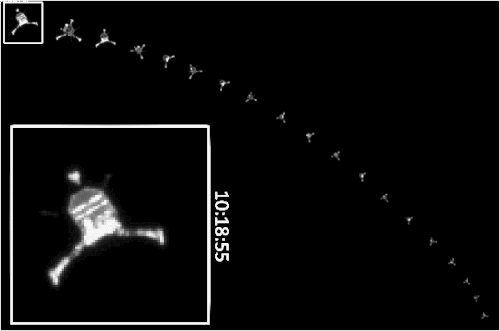
Image: A series of 19 images captured by Rosetta’s OSIRIS camera as the Philae lander descended to the surface of comet 67P/Churyumov-Gerasimenko on 12 November 2014. The timestamp marked on the images are in GMT (onboard spacecraft time).
Credit: ESA/Rosetta/MPS for OSIRIS Team MPS/UPD/LAM/IAA/SSO/INTA/UPM/DASP/ID
I often marvel in these pages at the ability of researchers to pull data out of malfunctioning spacecraft, going back to missions like Mariner 10, which was saved by using its solar panels to steady the spacecraft for all-important navigation fixes. With Philae we see another case of controllers doing everything they can to mitigate a bad situation. In its case, despite a landing that was anything but by the book, the lander completed numerous science measurements even as it bounced along its way to the Abydos site.
We learn in this ESA news release that 80 percent of the initial planned scientific activities were completed despite the bumpy arrival. For 64 hours after the separation from Rosetta, Philae took numerous images from above and on the cometary surface, studying organic compounds and providing data on the surface properties of 67P/Churyumov-Gerasimenko.
You’ll doubtless remember the rest: The lander was receiving insufficient sunlight to charge its secondary batteries, making data collection a race against the clock while the primary battery drained. Philae lapsed into hibernation on the 14th of November, 2014, though controllers had hopes that as the comet moved toward perihelion in August of 2015, the lander might awaken. And indeed on June 13, Philae resumed telemetry transmissions, with data showing that it had actually come back to life on April 26 but had not been able to send signals until June 13.
Contact with Philae in following weeks included seven intermittent links with Rosetta, the last coming on the 9th of July. Rosetta itself had to back off from 67P/Churyumov-Gerasimenko because of increased gas and dust activity as the comet warmed. Recently the activity levels have fallen enough to allow Rosetta to close to within 45 kilometers, but despite repeated passes over the landing area, no subsequent signal from Philae has been detected.
“The comet’s level of activity is now decreasing, allowing Rosetta to safely and gradually reduce its distance to the comet again,” says Sylvain Lodiot, ESA’s Rosetta spacecraft operations manager. “Eventually we will be able to fly in ‘bound orbits’ again, approaching to within 10-20 km – and even closer in the final stages of the mission – putting us in a position to fly above Abydos close enough to obtain dedicated high-resolution images to finally locate Philae and understand its attitude and orientation.”
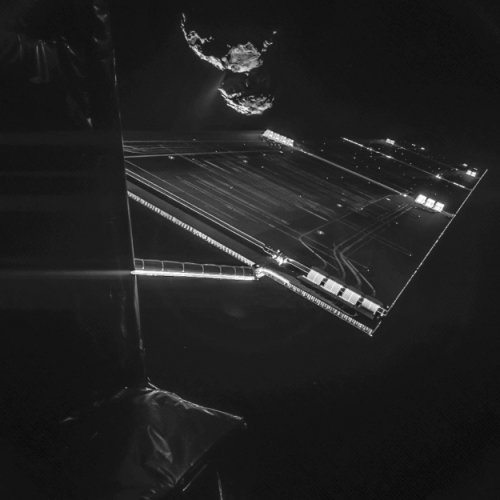
Image: Using the CIVA camera on Rosetta’s Philae lander, the spacecraft snapped a ‘selfie’ at comet 67P/Churyumov-Gerasimenko from a distance of about 16 km from the surface of the comet. The image was taken on 7 October and captures the side of the Rosetta spacecraft and one of Rosetta’s 14 m-long solar wings, with 67P/C-G in the background. Two images with different exposure times were combined to bring out the faint details in this very high contrast situation. The active ‘neck’ region of 67P/C-G is clearly visible, with streams of dust and gas extending away from the comet. Credits: ESA/Rosetta/Philae/CIVA.
Hopes of contacting the lander have faded given conditions on the surface, where dust may well be covering Philae’s solar panels. Moreover, there is no reason to think that Philae is in the same orientation or even location that it was in November of 2014, given the outflows of gas and dust the comet experienced last summer. Now 350 million kilometers from the Sun and on its way back out toward the outer system, the comet is at temperatures below the lander’s ability to operate.
Rosetta, despite all this, will keep listening for signals all the way in as it moves toward the comet for a landing in September. The odds get longer with each passing day:
“The chances for Philae to contact our team at our lander control centre are unfortunately getting close to zero,” says Stephan Ulamec, Philae project manager at the German Aerospace Center, DLR. “We are not sending commands any more and it would be very surprising if we were to receive a signal again.”

Pondering Gravitational Waves
“Einstein would be beaming,” said National Science Foundation director France Córdova as she began this morning’s news conference announcing the discovery of gravitational waves. I can hardly disagree, because we have in this discovery yet another confirmation of the reality of General Relativity. Caltech’s Kip Thorne, who discussed black hole mergers way back in 1994 in his book Black Holes and Time Warps, said at the same news conference that Einstein must have been frustrated by the lack of available technologies to detect the gravitational waves his theory predicted, a lack that it took a century to remedy with the LIGO collaboration.
Thorne believes that if he had been armed with the right tools, Einstein himself would have made the detection. But of course the tools weren’t there. Somehow that thought produced an odd echo of the very decade of General Relativity’s emergence, one that shows how much GR changed the nature of our view of the universe. It was in 1911, just four years before Einstein published GR, that Hugo Gernsback started talking about gravitational waves. The future editor of Amazing Stories, the first true science fiction magazine, Gernsback published his novel Ralph 124C 41+ in 1911, in a magazine called Modern Electrics.
Here’s how, in the era just before General Relativity, Gernsback handled gravitational waves, as our hero Ralph ponders his latest device:
It was known that certain high frequency currents would set up an interference with the gravitational waves, for it had been found in the first part of our century that gravitation was indeed a wave form, the same as light waves, or radio waves. When this interference between the two waves, namely, the gravitational waves and the electrical waves was discovered, it was found that a metallic screen charged by electric high frequency waves would indeed nullify gravitation to a certain extent…
And so on. Gernsback did his best (and at all too great a length), but how could his predictive powers have coped with gravitational waves? After all, his era was used to dealing with electromagnetic phenomena. General Relativity would stipulate a gravitational radiation which, like the electrical waves he mentioned, travels through space at the speed of light. But gravitational waves are themselves distortions — ripples — in spacetime itself. Finding gravitational waves means we have found yet another successful test of General Relativity in a kind of radiation different from any Gernsback could have imagined.
At Last, the Discovery
As fluctuations of expanding and contracting spacetime, we can think of gravitational waves as the movement of squeezed and stretched space. Accelerating bodies should produce these ripples, but only the largest events — a supernova explosion, a pair of infalling neutron stars, or even the collision between two black holes — should be sufficient to produce waves we can detect. The Laser Interferometer Gravitational-Wave Observatory (LIGO) experiment has been looking for these waves for more than a decade, with an upgraded Advanced LIGO in place since last September and far more sensitive than its predecessor.
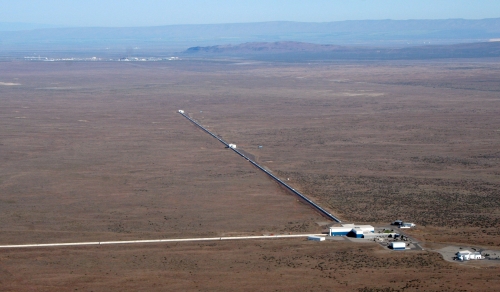
Image: An aerial view of the Laser Interferometer Gravitational-wave Observatory (LIGO) detector in Hanford, Washington. LIGO has two detectors: one in Livingston, Louisiana and the other in Hanford. LIGO is funded by NSF; Caltech and MIT conceived, built and operate the laboratories. Credit: LIGO Laboratory
LIGO has been searching for gravitational waves since 2002, involving the work of some 1000 scientists. Its laser interferometer apparatus, installed at stations in Hanford, Washington and Livingston, Louisiana, takes advantage of the fact that a passing gravitational wave should change the apparatus itself, shrinking or expanding the space between two objects.
A single laser beam is split into two, with the twin beams being sent on different paths perpendicular to each other down vacuum channels four kilometers long, bouncing off mirrors in the process and eventually recombining, still aligned. A gravitational wave passing through the experiment should be able to change the distance of the two paths, meaning that the beams are no longer in alignment — they no longer cancel each other out. The changes amount to no more than a tiny fraction of the width of an atomic nucleus but they have proven detectable.
A Date to Remember
Now we know that the first gravitational waves were detected on September 14, 2015 at 5:51 a.m. EDT (09:51 UTC) at both LIGO sites. The amalgamation of a black hole 36 times the mass of our Sun and another of 29 times solar mass has evidently created a Kerr black hole (one that is spinning) of 62 solar masses. The missing 3 solar masses are thought to have been converted into energy and released as gravitational waves in a fraction of a second, with a peak power output, according to this NSF news release, about 50 times that of the whole visible universe. The Livingston detector recorded the event 7 milliseconds before Hanford picked it up.
The two black holes collided some 1.3 billion years ago, in an area of the sky that can be only imprecisely determined because we have no more than the two detecting sites. Nonetheless, Gabriela Gonzalez (LSU), a spokesperson for the LIGO collaboration, was able to point to the southern sky in the region of the Large Magellanic Cloud. Bear in mind that we have help on the way — the Italian VIRGO interferometer, which will come close to LIGO sensitivity later this year, and detectors in progress at the Japanese Kamioka Gravitational Wave Detector (KAGRA) and another detector in the works at LIGO-India (which could be operational by 2022). And remember that the Laser Interferometer Space Antenna (LISA) Pathfinder, launched in December, has now reached L1.
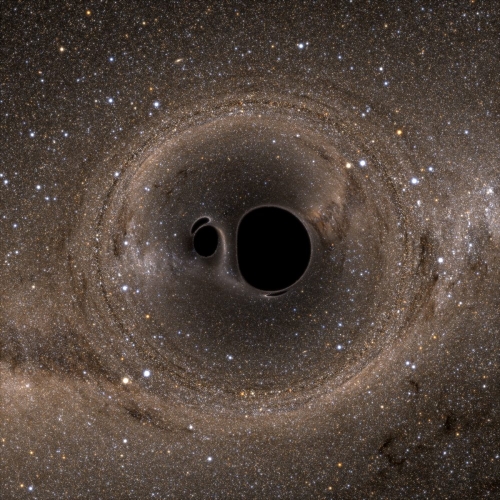
Image: Simulation of two merging black holes in front of the Milky Way. Scientists said the Sept. 14 event was so intense that in the moment before the colliding black holes swallowed each other, they emitted more energy than the rest of the universe combined. Credit: SXS Collaboration.
Toward a New Astronomy
We are, in other words, about to enter the era of gravitational wave astronomy. We’ve already learned as of this LIGO detection that binary black holes do exist, and that they can merge. A proven method of detecting gravitational waves should lead to our learning the signatures of different astronomical phenomena. Just how different is hard to ascertain, because as the oft-made comparison with Galileo’s first instrument reminds us, unexpected things turn up whenever we start looking with new tools. Gravitational waves provide us with a way of seeing into the earliest moments of the universe. And they’re certainly our way into violent processes like black hole and neutron star mergers and supernova explosions. Thus we move beyond electromagnetic wavelengths — visible light, X-rays, infrared — into a new era.
“At optical wavelengths,” Kip Thorne told the news conference, “we can see the universe as a calm place, like looking at the ocean on a quiet day. But on September 14, all that changed. Now we see an ocean of crashing waves, as black holes create a violent storm in the fabric of space and time.” Thorne went on to speak of the kind of detections that will be possible as gravitational wave astronomy advances, including not only the black holes, neutron stars and supernovae previously mentioned, but the possible detection of cosmic strings reaching across the cosmos, created by the process of inflation in the earliest moments of the universe.
“With this discovery,” adds Thorne, “we humans are embarking on a marvelous new quest: the quest to explore the warped side of the universe — objects and phenomena that are made from warped spacetime. Colliding black holes and gravitational waves are our first beautiful examples.”
The temporal distance between Gernsback’s first novel and Einstein’s General Relativity was four years. The distance between GR and gravitational wave detection was a century, a span of time in which the foundations of General Relativity have become part of the fabric of basic scientific literacy. A useful thought experiment is to put ourselves back in that pre-GR era and ponder just how dramatic the conceptual change that Einstein wrought must have been.
An Antiquarian Thought Experiment

The thought experiment is a way of seeing how preconceptions can be overturned dramatically, which is why I sometimes return to creaky old stories like Gernsback’s Ralph 124C 41+. It’s a famous novel in the annals of science fiction but only a turgid read. Brian Aldiss once described it as a “tawdry illiterate tale,” and its author evidently viewed its plot as little more than an on-ramp for his real purpose, describing futuristic technical marvels.
Gernsback was no Einstein, but then, who was? He was an inventor, a publisher with a large stable of magazines whose contributions to science fiction were large enough to have resulted in the annual Hugo awards being named for him. He was also famous for paying his writers very low fees (H. P. Lovecraft would call him ‘Hugo the Rat’). Few science fiction fans today have read Ralph 124C 41+, but that early 20th Century gusto for sweeping predictions about technology drew impetus from the book, energizing the nascent but energetic genre.
Image: Portrait of magazine publisher Hugo Gernsback(1884–1967) by Fabian Bachrach (1917–2010). Credit: Wikimedia Commons.
Today’s science fiction, with all its sub-genres, takes General Relativity as a starting point for what comes next even as it continues to poke at how the theory might be extended in ways useful both to science and to plot. It’s just possible that we’ll find something through gravitational wave astronomy within the next hundred years that is as wildly out of kilter with current thinking as General Relativity was in its day. We didn’t abandon Newtonian physics when we moved on to GR, we simply placed it in a wider context. Open a new portal into the universe and things happen. We can only wonder what science — and science fiction — will look like a century from now.
Today’s paper is “Observation of Gravitational Waves from a Binary Black Hole Merger,” Physical Review Letters 116 (11 February 2016) 061102 (full text). See also this useful backgrounder from the American Physical Society’s online journal Physics : Berti, “Viewpoint: The First Sounds of Merging Black Holes,” (full text).

A Future We Can Choose
The very small may lead us to the very large. Payload sizes, for one thing, can be shrunk as we increasingly master the art of miniaturization, giving us far more bang for the buck. In that sense, we can think about tiny interstellar probes that may one day be sent, as Robert Freitas has envisioned, in waves of exploration, each of them no larger than a sewing needle, but armed with artificial intelligence and capable of swarm-like behavior. Mastering the tiny thus enables the longest of all journeys.
But thinking about small payloads also makes me ponder much larger constructs. Suppose in a hundred years we can work at the atomic level to build structures out of the abundant raw material available in the asteroid or Kuiper belts. It’s possible to imagine enormous arcologies of the kind discussed by Gerard O’Neill that may one day house substantial human populations. In this way nanotech opens the door to renovation in the realm of gigantic colony worlds.
And if one of these colony worlds, eventually exploring ever deeper into the Solar System, becomes so taken with life off-planet that it continues its outward movement, perhaps we’ll see nearby stars explored in millennial time-frames, harvesting Oort Cloud materials and their counterparts among nearby stars. For that matter, could nanotech one day help us build the kind of lens structures Robert Forward envisioned to focus laser beams on departing interstellar craft containing humans? Using these technologies, Forward could work out travel times in decades rather than millennia. The art of the small may work in both these directions.

Image: Don Davis produced this image of a toroidal-shaped space colony for NASA, emphasizing not only its size but its closed ecosystem. Credit: Don Davis / NASA Ames Research Center.
The Next Hundred Years
Closer to our own time, virtual reality enabled by miniaturization and microsatellites may play a large role in how we explore Mars. Robotic bodies, as Emily Lakdawalla points out in a Nautilus essay called Here’s What We’ll Do in Space by 2116, have no need for the mammalian necessities of water and shelter. Putting robots on the Martian surface that serve as avatars for humans in Mars orbit would allow us to map and explore vast areas with minimal risk to life. Now we’re talking building up infrastructure of the sort that may eventually fill the Solar System.
A ‘virtual Mars’ from orbit is one Elon Musk would dislike, given his intention of walking the Martian surface one day, and given the growth of commercial space, it’s possible that private companies will be on the surface before a NASA or ESA-led robotic effort of the kind Lakdawalla imagines might be attempted. But surely there’s a rational mix between human and robotic to be found here. We’ll never tame the questing spirit that drives some to push for manned missions — nor should we — but the advantages of robotics will surely play a huge role in the creation of a human presence around and on whatever bodies we explore in the coming century.
I’m much in favor of Lakdawalla’s ideas on what happens next:
Most of the planets that we’ve discovered beyond the solar system are Neptune-sized, so it would behoove us to understand how this size of world works by visiting one with an orbiter. Uranus is closer, so quicker and easier to get to; but because of its extreme tilt, it’s best to visit near its equinox, an event that happens only once in 42 years. The last equinox was in 2007; I will be sorely disappointed if we do not have an orbiter at or approaching Uranus in 2049. But we may choose to orbit Neptune before we travel to Uranus, because Neptune has an additional draw: its moon Triton, likely a captured Kuiper belt object, and a world where Voyager 2 saw active geysers.
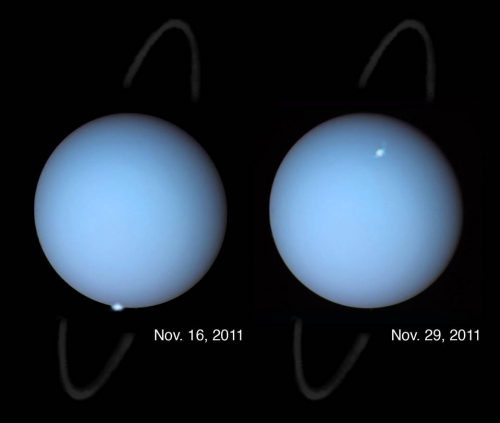
Image: Hubble observations of Uranus, among the first clear images, taken from the distance of Earth, to show aurorae on the planet. Imagine what we could learn with an orbiter in place here. Credit: NASA, ESA, and L. Lamy (Observatory of Paris, CNRS, CNES).
Triton may prove irresistible, especially given what we’ve seen at Pluto, but so too are Kuiper Belt objects like Haumea. This is an interesting place, a fast-spinner (about once every 3.9 hours) that is orbited by two moons, one of them (Hi’iaka) a whopping 300 kilometers in diameter. The scientific interest here is quickened by the belief that Haumea’s oblong shape resulted from a collision, perhaps giving us an opportunity to deeply investigate its composition. In any case, its highly reflective surface seems to be covered with water ice, so perhaps there is some form of cryovolcanism going on here. Triton again comes to mind.
For a look at a Haumea mission concept, see Fast Orbiter to Haumea and Haumea: Technique and Rationale, based on ideas Joel Poncy (Thales Alenia Space, France) presented at the Aosta interstellar conference back in 2009. But in weighing outer system missions, keep in mind as well the search for the putative Planet 9, the discovery of which would doubtless fuel speculation on the kind of technologies that might reach it. Lakdawalla mentions the possibility but, noting that the world would be ten times further out than Pluto, says that it would take a revolution in spacecraft propulsion to get to it in less than a hundred years.
The FOCAL Mission’s Allure
True enough, but the very presence of this intriguing object poses yet another driver for the development of technologies to reach it. So does a target with an equally compelling justification, the Sun’s gravitational lensing focus beginning at 550 AU. A spacecraft sent out from our system in such a trajectory that it would observe gravitational lensing of its target — on the other side of the Sun — could yield huge returns, given the vast magnifying power of the lens. Bear in mind that the focal line in a gravitational lens runs to infinity, so as the spacecraft receded, continuing observations could be made across a wide range of wavelengths.
FOCAL is the name of the mission, given Claudio Maccone’s championing of the concept and the name dating back to the early 1990s, and you can see the design of such a mission in his book Deep Space Flight and Communications: Exploiting the Sun as a Gravitational Lens (Springer, 2009). We continue to explore sail missions with gravity assist and, further in the future, beamed laser or microwave methods to reach the needed velocities.
Meanwhile, FOCAL’s allure is bright: As Michael Chorost writes in The Seventy Billion Mile Telescope, “For one particular frequency that has been proposed as a channel for interstellar communication, a telescope would amplify the signal by a factor of 1.3 quadrillion.” SETI anyone?
Then again, suppose Pale Red Dot, now working hard on Proxima Centauri using the HARPS spectrograph at ESO’s 3.6-meter telescope at La Silla, turns up an interesting planet in the habitable zone. Or perhaps David Kipping will find something in the MOST data he is currently working on. As we learned more about such a planet (and other possibilities around Centauri A or B), the idea of turning a FOCAL-like lens upon the stars would become irresistible.
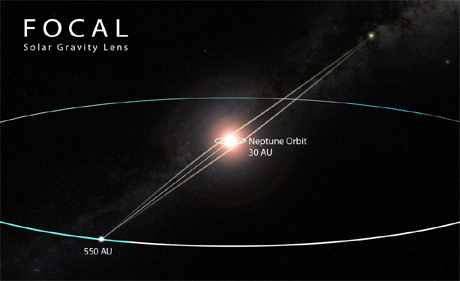
Image: Beyond 550 AU, we can start to take advantage of the Sun’s gravitational lens, which may allow astrophysical observations of a quality beyond anything we can do today. Credit: Adrian Mann.
With all this in mind, though, we can’t forget not only how far we have to go before we’re ready for FOCAL, but how many things we can accomplish much closer to home. Lakdawalla writes:
Some people have suggested floating balloons under the Venusian sulfuric-acid cloud deck to search for active volcanoes, or sending similar balloons under the smog of Saturn’s moon Titan to watch its methane rivers flow and possibly even touch down in a Titanian ethane lake. We’ve dreamed of touring the populations of icy worlds that float ahead of and behind the giant planets in their orbits; many of these worlds have binary companions, and some of them have rings. We’ve suggested setting up lunar bases on polar crater rims where the Sun always shines, and sending rovers into crater bottoms where the Sun never does, where water ice may have been preserved over the age of the solar system.
All true, and I still love the AVIATR concept (Aerial Vehicle for In-situ and Airborne Titan Reconnaissance), a 120 kg airplane fueled by Advanced Stirling Radioisotope Generators (ASRG), which demand less plutonium-238 than earlier RTGs and produce less waste heat. AVIATR could stay airborne in Titan’s benign conditions (benign, that is, because of a dense atmosphere and light gravity) for a mission lasting as long as a year, exploring the moon by powered flight. See AVIATR: Roaming Titan’s Skies for background on the concept. There has been no shortage when it comes to intriguing concepts for exploring Titan.
My belief is that an interplanetary infrastructure will one day lead to our first interstellar missions, but just when those will occur is impossible to know. In any case, building the infrastructure will be so fraught with discovery that every step of the way is cause for celebration, assuming we have the sense to continue the push outwards. That, of course, is an open issue, and I suspect there will never be a time when expansion into space is anything but controversial. As always, I fall back on Lao-Tzu: “You accomplish the great task by a series of small acts.”
Keep working.

Inside Rocky Exoplanets
We’ve gone from discovering the presence of exoplanets to studying their atmospheres by analyzing the spectra produced when a planet transits in front of its star. We’re even in the early stages of deducing weather patterns on some distant worlds. Now we’re looking at probing the inside of planets to learn whether their internal structure is something like that of the Earth.
The work is led by Li Zeng (Harvard-Smithsonian Center for Astrophysics), whose team developed a computer model based on the Preliminary Reference Earth Model (PREM), the standard model for the Earth’s interior. Developed by Adam Dziewonski and Don L. Anderson for the International Association of Geodesy, PREM attempts to model average Earth properties as a function of radius. Zeng adjusted the model for differing masses and compositions and applied the revised version to six known rocky exoplanets with well understood characteristics.
The work shows that rocky worlds should have a nickel/iron core that houses about thirty percent of the planet’s mass, with the remainder being mantle and crust. “We wanted to see how Earth-like these rocky planets are,” says Zeng. “It turns out they are very Earth-like.”
From the paper:
These dense exoplanets between 2 and 5 M? so far appear to agree with the mass-radius relation with CMF [Core Mass Fraction] ? 0.26, suggesting that they are like the Earth in terms of their proportions of mantle and core. But their surface conditions are utterly different as they are much too hot. This is due to observational bias that currently it is much easier for us to detect close-in planets around stars. The fact that we now see so many of them suggests there may be abundant Earth-like analogs at proper distances from their stars to allow existence of liquid water on their surfaces.
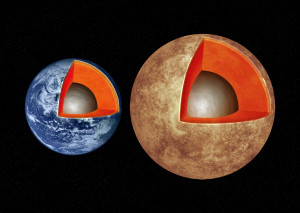
Image: This artist’s illustration compares the interior structures of Earth (left) with the exoplanet Kepler-93b (right), which is one and a half times the size of Earth and 4 times as massive. New research finds that rocky worlds share similar structures, with a core containing about a third of the planet’s mass, surrounded by a mantle and topped by a thin crust. M. Weiss/CfA.
The paper points out that these conclusions fit with studies of disintegrated planet debris in polluted white dwarf spectra. Here the remnant of a star like the Sun has evidently swallowed up planetary materials, usefully producing spectra that can be analyzed to see what elements emerge. Such studies indicate debris that resembles the composition of the Earth, where over 85 percent of the mass is composed of oxygen (O), magnesium (Mg), silicon (Si), and iron (Fe). Moreover, we find similar ratios of iron to silicon and magnesium to silicon. These ratios indicate formation processes similar to those we find in our own Solar System:
Current planet formation theory suggests that the solar nebula was initially heated to very high temperatures to the extent that virtually everything was vaporized except for small amount of presolar grains… The nebula then cools to condense out various elements and mineral assemblages from the vapor phase at different temperatures according to the condensation sequence… Fe-Ni [nickel] metal alloy and Mg-silicates condense out around similar temperatures of 1200-1400K (depending on the pressure of the nebula gas) according to thermodynamic condensation calculation… Oxygen, on the other hand, does not have a narrow condensation temperature range, as it is very abundant and it readily combines with all kinds of metals to form oxides which condense out at various temperatures as well as H [hydrogen], N [nitrogen], C [carbon] to form ices condensing out at relatively low temperatures… As supported by the polluted white dwarf study, we expect other exoplanetary systems to follow similar condensation sequence as the solar system in a H-dominated nebular environment for the major elements: Fe, Mg, Si, and O…
The assumption of chemical compositions similar to the Earth’s may come into question in parts of the galaxy that are less rich in metals, in which case different planetary interior structures could evolve, a subject Zeng and team plan to investigate in future research.
The paper is Zeng et al., “Mass-Radius Relation for Rocky Planets based on PREM,” accepted at The Astrophysical Journal (preprint).

Probing the Interior of a Comet
Knowing what comets are made of — dust and ice — only begins to answer the mystery of what is inside them. A compact object with this composition should be heavier than water, but we know that many comets have densities much lower than that of water ice. The implication is that comets are porous, but what we’d still like to know is whether this porosity is the result of empty spaces inside the comet or an overall, homogeneous low-density structure.
For answers, we turn to the European Space Agency’s continuing Rosetta mission. In a new paper in Nature, Martin Pätzold (Rheinische Institut für Umweltforschung an der Universität zu Köln, Germany) and team have gone to work on the porosity question by analyzing Comet 67P/Churyumov-Gerasimenko, around which Rosetta travels. It’s no surprise to find that 67P/Churyumov-Gerasimenko is a low-density object, but an examination of the comet’s gravitational field shows that we can now rule out a cavernous interior.
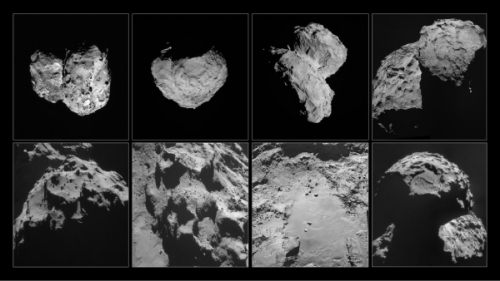
Image: These images of comet 67P/Churyumov-Gerasimenko were taken by Rosetta’s navigation camera between August and November 2014. Top row, left to right: Comet pictured on 6 August 2014, at a distance of 96 km; 14 August, at a distance of 100 km; 22 August, at a distance of 64 km; 14 September, at a distance of 30 km. Bottom row, left to right: Comet pictured on 24 September, at a distance of 28 km; 24 October, at a distance of 10 km; 26 October, at a distance of 8 km; 6 November, at a distance of 30 km. Copyright: ESA/Rosetta/NAVCAM, CC BY-SA IGO 3.0.
This is tricky work performed using Rosetta’s Radio Science Experiment (RSI) to examine just how the Rosetta orbiter is affected by the gravity of the comet. And just as we do when measuring the tiniest motions of distant stars to search for planetary companions, the researchers use Doppler methods to make the call, measuring how signals from the spacecraft change in frequency as Rosetta is affected by the comet’s gravity. In this way we can build up a picture of the gravity field across the comet while working to rule out other influences.
“Newton’s law of gravity tells us that the Rosetta spacecraft is basically pulled by everything,” says Pätzold, the principal investigator of the RSI experiment. “In practical terms, this means that we had to remove the influence of the Sun, all the planets – from giant Jupiter to the dwarf planets – as well as large asteroids in the inner asteroid belt, on Rosetta’s motion, to leave just the influence of the comet. Thankfully, these effects are well understood and this is a standard procedure nowadays for spacecraft operations.”
As this ESA news release explains, the team wasn’t through even after compensating for all these other Solar System bodies. Also to be considered was the pressure of solar radiation and the gas escaping through the comet’s tail. Rosetta uses an instrument called ROSINA to measure the flow of gas past the spacecraft, allowing its effect to be measured. No sign of large internal caverns emerged from the analysis.
We’re lucky with 67P/Churyumov-Gerasimenko in that the comet turned out not to be round, as ground-based observations had previously suggested. As we’ve gotten to know the comet, its distinctive double-lobed shape has proven not only visually interesting but scientifically helpful. The twin lobes mean that differences in the gravity field are more pronounced and easier to study from the 10 kilometer distance Rosetta had maintained for reasons of safety. With variations in the gravity field already showing from 30 kilometers out, the much richer measurements from 10 kilometers could proceed.
The result: Comet 67P/Churyumov-Gerasimenko is found to have a mass of slightly less than 10 billion tonnes. By using images from Rosetta’s OSIRIS camera, the team was able to model the comet’s shape so as to produce a volume of approximately 18.7 km3, yielding a density of 533 kg/m3. Given this and the lack of large interior spaces, we can look at the comet’s porosity as a property of its constituents. Rather than a compacted solid, comet dust is more of a ‘fluffy’ aggregate of high porosity and low density.
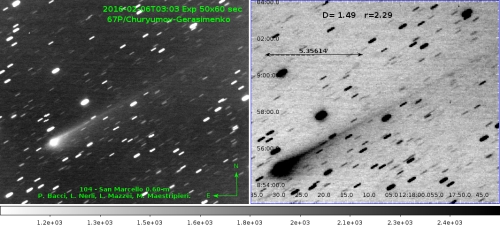
Image: Rosetta from Earth, in an image taken by Paolo Bacci on February 6, 2016 from San Marcello Pistoiese, Italy.
Keep your eye on Rosetta. In September, the spacecraft will be brought in for a controlled impact on the surface, a challenging navigational feat for controllers at ESA’s European Space Operations Centre (ESOC) in Darmstadt, Germany. Closing on the comet will allow the gravity observations to continue at a much higher level of detail, making it possible for caverns only a few hundred meters across to be detected, if indeed they are there at all.
The paper is Pätzold et al., “A homogeneous nucleus for comet 67P/Churyumov-Gerasimenko from its gravity field,” Nature 530 (04 February 2016), 63-65 (abstract).


